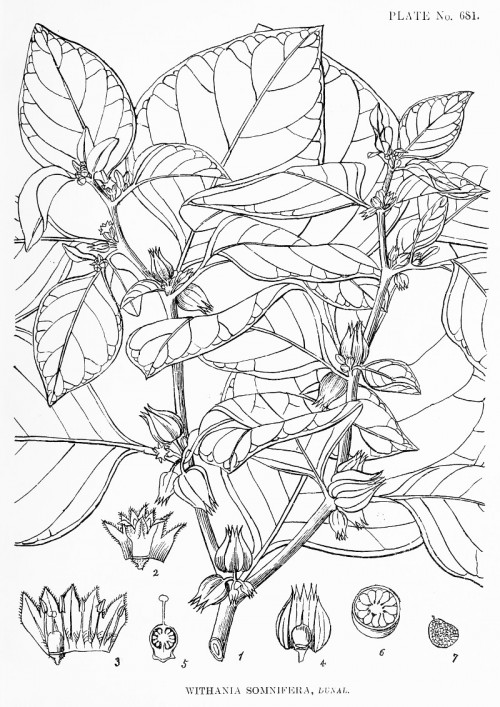Withania somnifera (L.) Dunal - syn. Physalis somnifera L. - Solanaceae
Ashwagandha, Indian Ginseng, winter cherry, Schlafbeere, Winterkirsche
Shrubby, semi-woody, perennial herb, up to 150cm high; native in China, Afghanistan, Pakistan, India, and central to southern Africa. http://www.tropicos.org/Name/29600341?tab=distribution
„The (Ashwagandha) and its root are due to their versatile effects one of the most frequently used drugs in Ayurvedic medicine. It may be compared in importance with that of ginseng for the Chinese medicine. They are used to thread impotence, inflammation and insomnia.“
http://de.wikipedia.org/wiki/Withania_somnifera
„A methanolic extract of W. somnifera root inhibited the specific binding of [3H]GABA and [35S]TBPS, and enhanced the binding of [3H]flunitrazepam to their putative receptor sites… In functional studies using 36Cl-influx assay in mammalian spinal cord neurons, W. somnifera root extract increased 36Cl-influx in the absence of GABA. This effect on 36Cl-influx was blocked by bicuculline and picrotoxin; and enhanced by diazepam. These results suggest that the W. somnifera extract contains an ingredient which has a GABA-mimetic activity.“
[Pharmacological effects of Withania somnifera root extract on GABAA receptor complex., Mehta, A.K., Binkley, P., Gandhi, S.S., Ticku, M.K., The Indian journal of medical research, Vol.94, 1991, 312-315.]
„The roots of Withania somnifera (WS) are used extensively in Ayurveda, the classical Indian system of medicine, and WS is categorized as a rasayana, which are used to promote physical and mental health, to provide defence against disease and adverse environmental factors and to arrest the aging process. WS has been used to stabilize mood in patients with behavioural disturbances. The present study investigated the anxiolytic and antidepressant actions of the bioactive glycowithanolides (WSG), isolated from WS roots, in rats… WSG induced an anxiolytic effect, comparable to that produced by lorazepam, in the elevated plus-maze, social interaction and feeding latency in an unfamiliar environment, tests. Further, both WSG and lorazepam, reduced rat brain levels of tribulin, an endocoid marker of clinical anxiety, when the levels were increased following administration of the anxiogenic agent, pentylenetetrazole. WSG also exhibited an antidepressant effect, comparable with that induced by imipramine, in the forced swim-induced ‘behavioural despair’ and ‘learned helplessness’ tests. The investigations support the use of WS as a mood stabilizer in clinical conditions of anxiety and depression in Ayurveda.“
[Anxiolytic-antidepressant activity of Withania somnifera glycowithanolides: an experimental study. S.K. Bhattacharya,A. Bhattacharya, K. Sairam, S. Ghosal, Phytomedicine, Vol.7 (6), 2000, 463–469]
„The major chemical constituents of these plants, withanolides, are mainly localized in leaves, and their concentration usually ranges from 0.001 to 0.5% dry weight. The withanolides are a group of naturally occurring C28-steroidal lactones built on an intact or rearranged ergostane framework, in which C-22 and C-26 are appropriately oxidized to form a six-membered lactone ring. The basic structure is designated as the withanolide skeleton… Withaferin A (4β,27-dihydroxy-1-oxo-5β,6β-epoxywitha-2-24-dienolide, Figure 3) was the first member of this group of compounds to be isolated … The structural novelty and interesting biological activities elicited by this compound led to a thorough chemical investigation of the plant and numerous compounds with similar structural features were isolated.“
[Steroidal Lactones from Withania somnifera, an Ancient Plant for Novel Medicine. Mohammad Hossein Mirjalili, Elisabeth Moyano, Mercedes Bonfill, Rosa M. Cusido, Javier Palazón, Molecules 2009, 14(7), 2373-2393] http://www.mdpi.com/1420-3049/14/7/2373/pdf

Kirtikar, K.R., Basu, B.D., Indian medicinal plants, Plates, vol.4, t.681 (1918)
http://plantgenera.org/species.php?id_species=1075114

Aswagandha plant and roots, source: wikimedia Author: Piouswatson